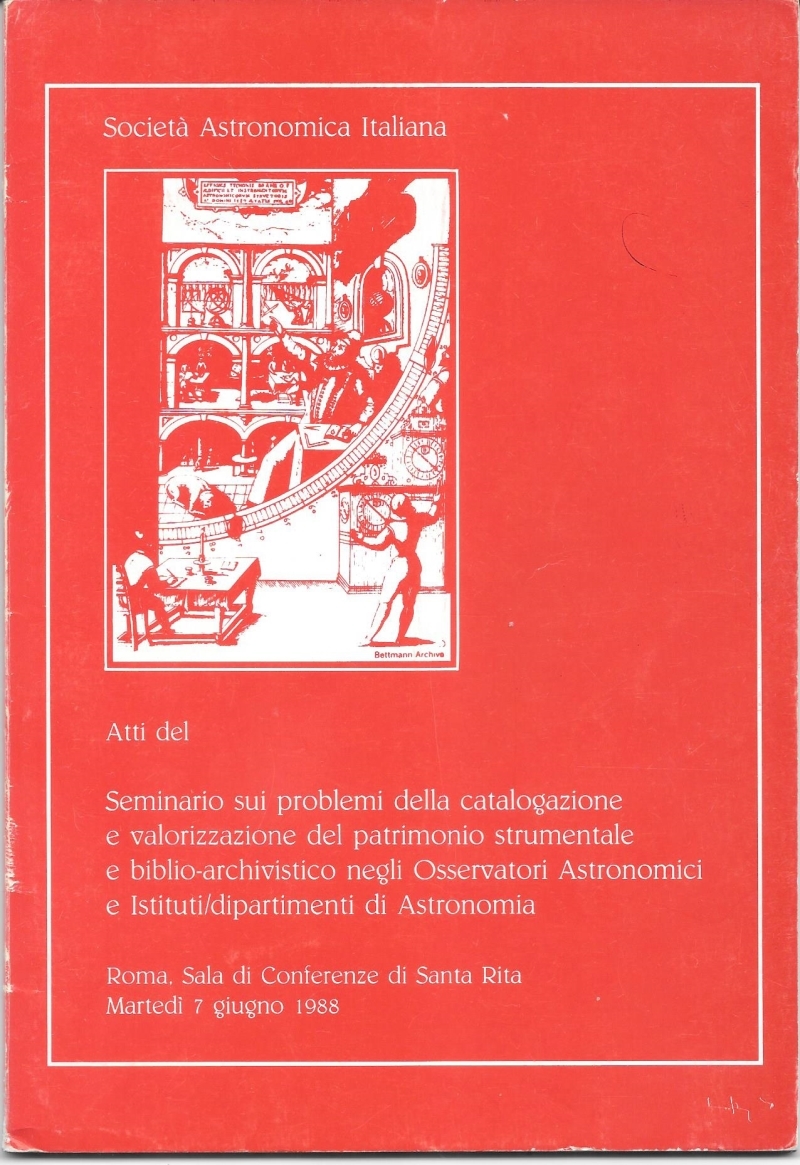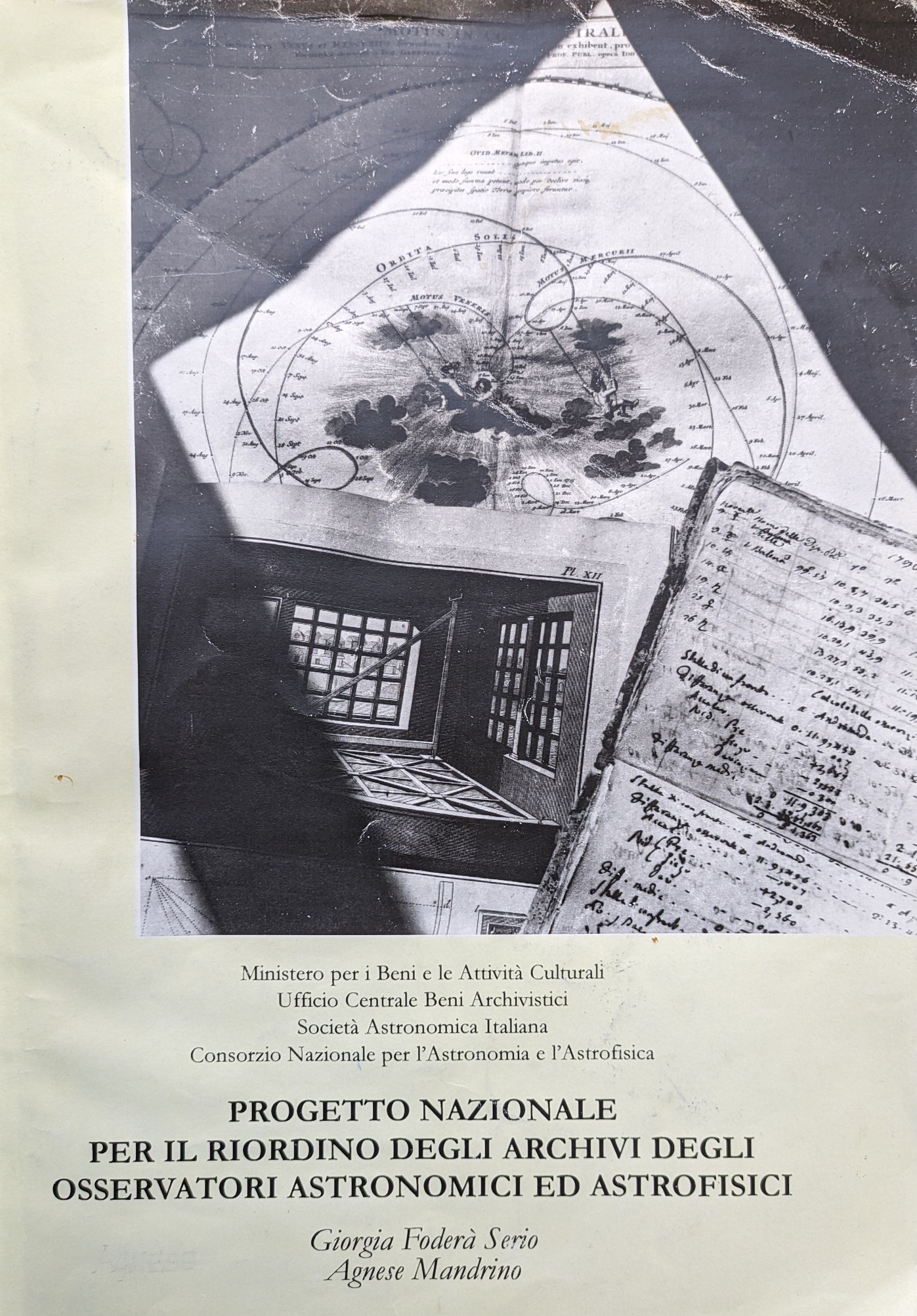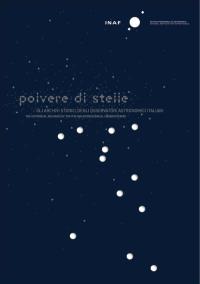The historical archives of the Observatories: history of a reorganization
Astronomical Observatories are among the oldest scientific research institutions operating in Italy; often dating back to the eighteenth century they preserve archives, libraries and scientific instrumentation of the highest value. Some of the buildings, which have remained the same since their foundation, are historic buildings of great artistic value: Palazzo Brera in Milan, Torlonga in Padua, Capodimonte Observatory in Naples, Palazzo Poggi in Bologna and the Pisan Tower in Palazzo dei Normanni in Palermo.
The archives of the Observatories, preserving documentation relating both to astronomical and meteorological observations and to the correspondence of astronomers, are a mine of news not only scientific but also of a private, political and social nature, that allow us a greater knowledge, beyond that of the evolution and the expansion of the scientific thought, of the History.
The series of meteorological observations, for example, now assume great scientific importance in the field of climatology. All scientific projects for the reconstruction of the climates of the past are based mainly on the analysis of the series of meteorological data collected and stored at the Observatories that constituted, thanks to the advent of the telegraph, the first Italian meteorological network.
The observatories' historical legacy also demonstrates their significant impact on daily life. We could cite many examples, such as the construction of the large sundials in the cathedrals of Palermo, Milan and Bologna; the compilation of ephemeris for navigation; the collaboration with engineers for the drafting of correct maps; the adjustment of the clocks; the preparation of calendars; the cooperation with the Judicial Authority to assess the reliability of evidence; the creation of a national and international meteorological network.
The pioneers
Since the early eighties of the last century, a widespread international interest in the history of science highlighted the great problem of the conservation, reorganization and inventory of the archival heritage of Italian astronomical observatories.

From 1983, the first Observatory to implement a program of protection and safeguard of its historical archive was that of Brera in Milan, whose reorganization has brought out not only the aspects of the institutional and scientific history of the Observatory but also the importance of the Observatories as sources for the study of the history of Astronomy.
The importance of documentation preserved in historical archives became clear after Brera's experience. On 7 June 1988 the Commission of the History of Astronomy of the Italian Astronomical Society organized in Rome the first meeting dedicated to the problems of recovery and re-ordering of instrumental and biblio-archival resources in the Observatories and Institutes of Astronomy and Astrophysics in Italy. This was followed by a second meeting on 10 November 1989 in Pisa and athird on 27 April 1993 in Rome.
In the meantime, in the wake of what was done at Brera and of the meetings mentioned above, other Observatories started to survey what they had, catalog the correspondence, compile inventories: Turin, Palermo, Bologna, Naples, Arcetri, Rome. In some cases the works were completed, in others sketched, in others still concerned only a part of the documentation, but the road towards the awareness that the historical archives were to be reorganized, protected and made available was now open.
The “Specola 2000” Project
In July 1999, an agreement between the Directorate-General for Archival Heritage of the Ministry of Cultural Heritage and Activities, the National Consortium for Astronomy and Astrophysics and the Italian Astronomical Society started the drafting of a National Project for the protection and enhancement of the documentary heritage owned by the astronomical observatories of our Country.

The Project was financed mainly with funds from the Directorate-General mentioned above, integrated with other funds made available by the individual Observatories, and later ny the so-called "5‰ Funds" of the Italian State. The Scientific Reference provided by the Superintendence of Archives responsible for the territory ensured the accuracy of the reorganization and inventory operations.
The purpose of Project, entitled “Specola 2000” from the year when it began, was to reorganize and inventory the historical archives of all the Italian astronomical observatories, to prepare, publish and make available on the net appropriate tools, to open the archives to consultation and enhance them, ensuring the support of adequately trained personnel, in compliance with current legislation.
The operational commission, formed by Maria Grazia Pastura, Giorgia Foderà Serio, Agnese Mandrino and Luisa Schiavone, after a thorough census of the documentary heritage of the Observatories, prepared a report on the real situation of the archives. They proposed interventions aimed at the realization of the Project, the priority of which was the reorganization and inventory of all those historical archives (until 1960) that were without inventory or that had a partial one.
In the following years Micaela Procaccia, officer of the Directorate-General of Archival Heritage, joined the operational commission. Starting from 2004, the coordination of the Project, after the mandate of Prof. Giorgia Foderà Serio of the University of Palermo, was entrusted to Prof. Fabrizio Bonoli of the University of Bologna.
In the meantime, compared to the beginning of the Project, the twelve astronomical and astrophysical observatories underwent a considerable change in legal status. According to Legislative Decree 23 July 1999 No. 296, the National Institute of Astrophysics (INAF) was established, as a research institute with legal personality under public law. Starting January 1, 2002, the twelve Observatories lost their legal status and merged with the INAF, who was responsible for coordinating their activities.
The last rearrangements

After the “Specola 2000” Project, due also to the exhaustion of the available funds, the National Institute of Astrophysics was responsible for concluding the inventories of the archives not yet completed and making available online the available inventories.
Since 2002, therefore, the activities related to the reorganization, protection and enhancement of the historical archives have been managed (in agreement with the Head of each Observatory's Archive) by the Library and Historical Archives Service, coordinated by Antonella Gasperini and for a short period by Luisa Schiavone. In particular, the Service mentioned above financed the recovery of documentary material in the Observatories of Padua, Arcetri and Rome. Furthermore, in 2009, on the occasion of the International Year of Astronomy, the web portal “Stardust” was created. It was initially dedicated to historical archives but was later expanded to include other types of cultural heritage, such as books and scientific instruments.
The activities related to the historical archives of astronomical observatories continue within the Libraries, Museums and Third Mission Service of the National Institute of Astrophysics, coordinated by Antonella Gasperini. Inventories, other equipment, digitalizations, events and everything related to historical archives are now merged in the portal “Stardust. The cultural heritage of Italian astronomy”, in addition to information on bibliographical and instrumental heritage.
The project of reorganization of the archives is still in progress, due to the decentralized nature of the Italian Observatories and the great wealth of documents and archival funds. Currently (June 2024) the reorganization of the Trieste archive remains to be completed.
As the archives are reorganized they are merged into SICAP database, with which INAF manages the inventories of its historical archives, and can be searched from the portal "Polvere di stelle" with the exception of the Bologna archive, that belongs to the University and can only be consulted from the University’s website.